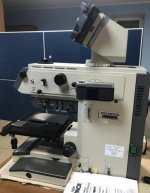Milling man
Hot Rolled
- Joined
- Aug 6, 2021
- Location
- Moscow, Russia
Hello colleagues.
In our work, we use face mills with diamond inserts. These cutters are individually adjustable for each tooth so that they all have the same height. The tolerance of even the most accurate indexable inserts is 10-20 microns, and the maximum error should be 1-2 microns. This process is well described here - https://mapal.com/medias/sys_master...for-PCD-face-milling-cutters-System-Power.pdf
Diamond plates VERY do not like contact methods of measurement. Microchip occurs instantly on them. Therefore, we adjust the cutter using a microscope with a camera - we put it on the machine, insert the face mill into the spindle. Then we orient the spindle to the desired angle and adjust each tooth. The problem is that our microscope has a very small working distance, about 1.5 millimeters. Therefore, we are forced to look at the plate from the side. At the same time, we see an indistinct edge of the plate - this makes work difficult.
Now I'm looking for some kind of "microscope" with which we can look at the front side of the plates when setting up. The cutter has a diameter of 125mm, so we need a "microscope" with a working distance of at least 45mm (1.77 inches).
I specifically put the word microscope in quotation marks, because I'm not sure that we need a microscope.
Our camera has a pixel size on a matrix of 1.35x1.35 microns. With the microscope we are currently using, we have a magnification of about x11. The camera lens has a magnification x0.5. As a result, when the cutter tooth moves 1 micron, it moves 4 pixels on the screen - this is good.
According to my calculations, we need some kind of optical device that will allow us to mount a camera from a microscope, with a magnification of about x6-x10 and a working distance of 45-60mm (1.77-2.36 inches).
I know we can just buy a $200,000 Zoller But now we've almost solved the problem with a $90 camera and an old microscope that costs me about $300. Therefore, I hope to find something that will finally solve all our difficulties.
I almost forgot one of the most important requirements - this optical device must have some kind of precise surface on the outside so that we can accurately align it with respect to the axes of the machine. The cutter teeth have a radial runout of about 10-30 microns, this runout is not adjustable, and if the axis of the microscope is not parallel to the axis of the machine, this will lead to measurement errors.
Now we have a camera like this: 2K 21MP 1080P 60FPS HDMI USB Electronic Industrial Microscope Camera 0.5X Eyepiece Adapter 30mm/30.5m Ring for Phone PCB Repair|Microscopes| - AliExpress
In our work, we use face mills with diamond inserts. These cutters are individually adjustable for each tooth so that they all have the same height. The tolerance of even the most accurate indexable inserts is 10-20 microns, and the maximum error should be 1-2 microns. This process is well described here - https://mapal.com/medias/sys_master...for-PCD-face-milling-cutters-System-Power.pdf
Diamond plates VERY do not like contact methods of measurement. Microchip occurs instantly on them. Therefore, we adjust the cutter using a microscope with a camera - we put it on the machine, insert the face mill into the spindle. Then we orient the spindle to the desired angle and adjust each tooth. The problem is that our microscope has a very small working distance, about 1.5 millimeters. Therefore, we are forced to look at the plate from the side. At the same time, we see an indistinct edge of the plate - this makes work difficult.
Now I'm looking for some kind of "microscope" with which we can look at the front side of the plates when setting up. The cutter has a diameter of 125mm, so we need a "microscope" with a working distance of at least 45mm (1.77 inches).
I specifically put the word microscope in quotation marks, because I'm not sure that we need a microscope.
Our camera has a pixel size on a matrix of 1.35x1.35 microns. With the microscope we are currently using, we have a magnification of about x11. The camera lens has a magnification x0.5. As a result, when the cutter tooth moves 1 micron, it moves 4 pixels on the screen - this is good.
According to my calculations, we need some kind of optical device that will allow us to mount a camera from a microscope, with a magnification of about x6-x10 and a working distance of 45-60mm (1.77-2.36 inches).
I know we can just buy a $200,000 Zoller But now we've almost solved the problem with a $90 camera and an old microscope that costs me about $300. Therefore, I hope to find something that will finally solve all our difficulties.
I almost forgot one of the most important requirements - this optical device must have some kind of precise surface on the outside so that we can accurately align it with respect to the axes of the machine. The cutter teeth have a radial runout of about 10-30 microns, this runout is not adjustable, and if the axis of the microscope is not parallel to the axis of the machine, this will lead to measurement errors.
Now we have a camera like this: 2K 21MP 1080P 60FPS HDMI USB Electronic Industrial Microscope Camera 0.5X Eyepiece Adapter 30mm/30.5m Ring for Phone PCB Repair|Microscopes| - AliExpress


 Tomorrow I will try to bring the camera from the microscope home, look through the eyepiece of the telescope and try to determine the magnification.
Tomorrow I will try to bring the camera from the microscope home, look through the eyepiece of the telescope and try to determine the magnification.

